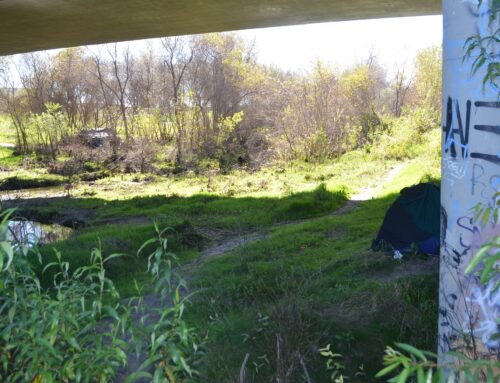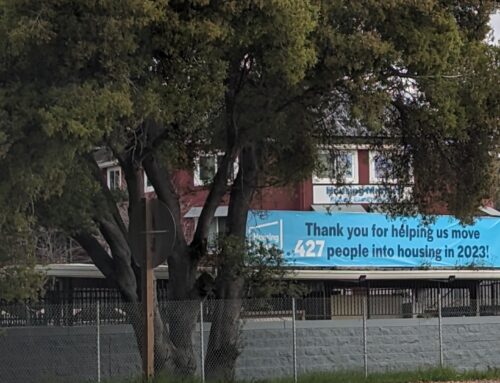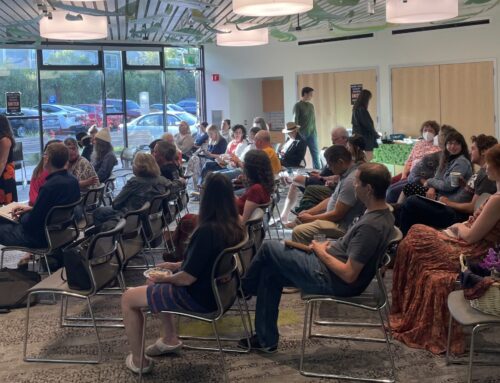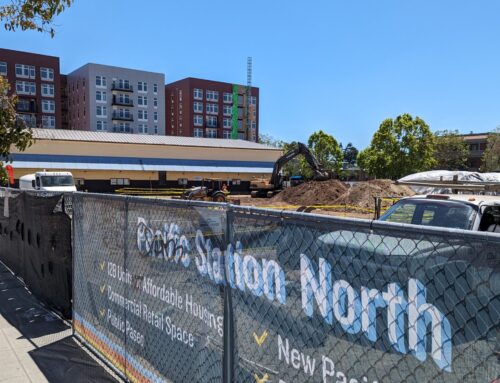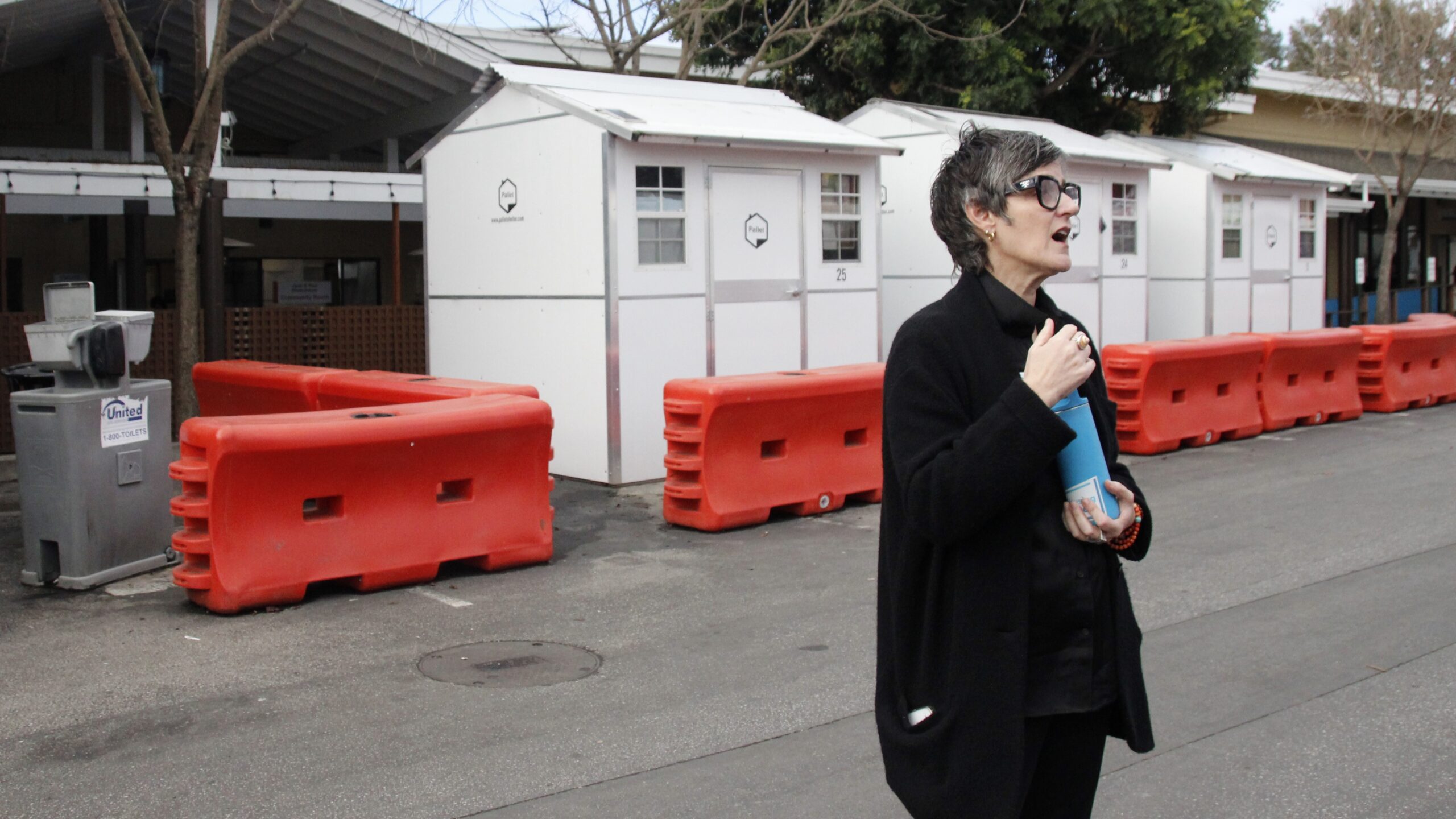
Housing Matters Chief Impact Officer Mer Stafford speaks in front of pallet shelters for unhoused residents at the Housing Matters campus on Coral Street in Santa Cruz in January. (Jesse Kathan — Santa Cruz Local)
Correction: One hundred twenty-one unhoused people moved into permanent homes through city programs since 2022, Santa Cruz city staff said. An earlier version of this story misstated the number of unhoused people who moved into permanent homes in the city in that period.
SANTA CRUZ >> Santa Cruz city leaders on Wednesday said 121 unhoused people moved into permanent housing through city programs since 2022, and hundreds more were served by homeless service programs. They also renewed calls for more city money to address homelessness because millions in one-time funds are expected to run out in July.
An online meeting led by Santa Cruz Deputy City Manager Lisa Murphy and Homelessness Response Manager Larry Imwalle highlighted recent progress of a three-year Homelessness Response Action Plan. The Santa Cruz City Council approved the plan in March 2022.
Read Santa Cruz Local's Election Guide
The three-year plan included:
- Shelter, hygiene and storage services. Leaders wanted to eliminate unsanctioned homeless camps and move people to managed shelters in the city and throughout the county.
- Increased capacity and partnerships to improve city staff’s coordination of services. Leaders wanted to expand mental health and addiction treatment, outreach, shelter and job training for homeless people. They also pledged to prioritize environmental restoration.
- RV parking and law enforcement. The plan called for equitable law enforcement and an updated model for deployment of police to calls related to homelessness.
- Expansion of affordable housing and supportive housing.
Part of the plan’s focus was to “establish permanent shelter sites with a higher standard of service that can really focus on breaking the cycle of homelessness and put more sustainable solutions in place,” Santa Cruz City Manager Matt Huffaker said at the time. It was primarily funded by $14 million from the state in 2021.
Wednesday, Murphy said that since 2022:
- 121 people found stable homes.
- 165 tents and other safe sleeping places are at 1220 River St. and the National Guard Armory near DeLaveaga Golf Course.
- 776 people have used safe sleeping and safe parking shelter programs.
- 948 tons of litter were picked up by city street cleaning programs.
- 960 new affordable housing units have been built.
- 30% total reduction in homelessness in the city from 2020 to 2023. Murphy said the city’s efforts helped this cause.
“We really want to prioritize services that would be most beneficial and helpful,” Imwalle said. “They are the experts on what they need.”
Imwalle added, “We receive regular and ongoing feedback from our shelter program participants, up at 1220 (River St.), at safe parking programs, at the city overlook. And we get this through individual check-ins and through onsite community meetings.”
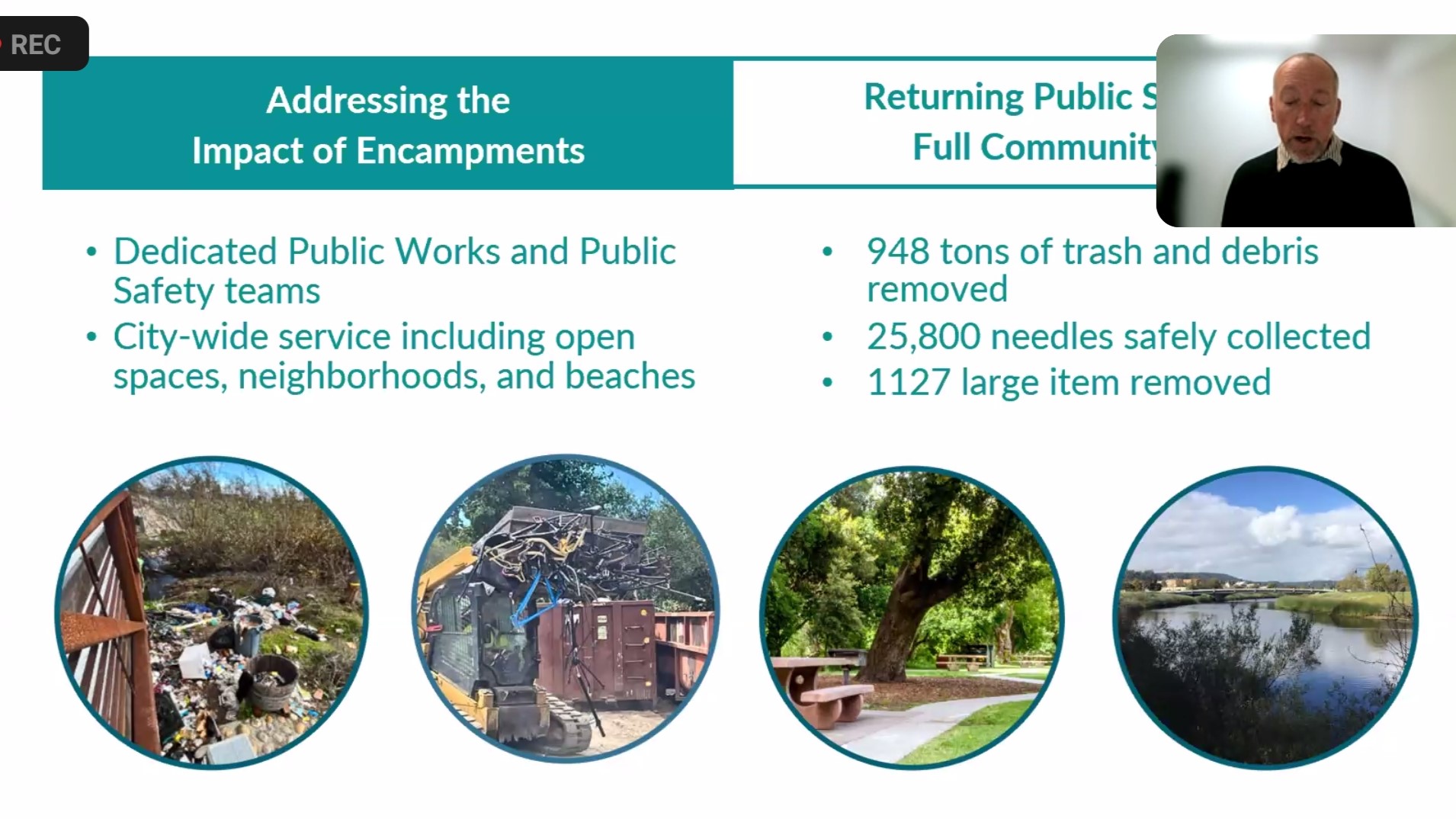
Santa Cruz Homelessness Response Manager Larry Imwalle discusses trash and syringes removed from tent camps in Santa Cruz since 2022. (City of Santa Cruz screenshot)
Homeless services in the city include:
- Safe sleeping programs, including the tent-based programs at the Armory and 1220 River St. The Armory has space for 135 people and provides limited case management services. The River Street camp is self-managed with external support and has space for 30 people. It requires and provides case management. About 4 in 10 of its participants have found permanent homes, city staff said. The Armory and River Street camps are at capacity, Imwalle said.
- Severe weather shelter, including at Depot Park and the Santa Cruz Veterans Hall. The County of Santa Cruz and cities of Santa Cruz and Watsonville have the capacity to provide 116 beds during extreme weather. The shelters have been open 13 nights this winter.
- Safe parking programs, including the city’s overnight-only programs operating in downtown parking lots 2, 3, 4, 8 and 25 with space for 32 total participants. The long-term parking program at the Armory is operated by Free Guide with space for 20 people. The city’s overnight-only program is permit-based and lasts for 30 days with the possibility of renewal each month, and has around 20 regular participants. Seven participants have gone from the city’s overnight-only program to the long term program at the Armory, Homeless Services Coordinator Megan Bunch said. The long-term program provides space for six months with the possibility of extension and has a housing rate of 40%, Imwalle said.
- Tent camp response, including “connecting with people living in encampments to provide support like trash bags, and additional refuse collection,” said Imwalle. The city also spends money on homeless camp sweeps, including $1 million spent clearing the benchlands in 2022 as part of a restoration project.
Looking ahead, Imwalle highlighted the need for sustainable funding sources and increased collaboration with the county, and sourcing insight from people with experience of homelessness. He said city staff recently applied for funding from the state’s Encampment Resolution Funding Program, which provides money for clearing homeless camps and rehousing efforts. He also highlighted legislative and advocacy efforts to bring money to the city.
“Being able to continue to support these existing programs, particularly the shelter and safe sleeping capacities is really critical. So that is a focus and a priority for us,” said Imwalle.
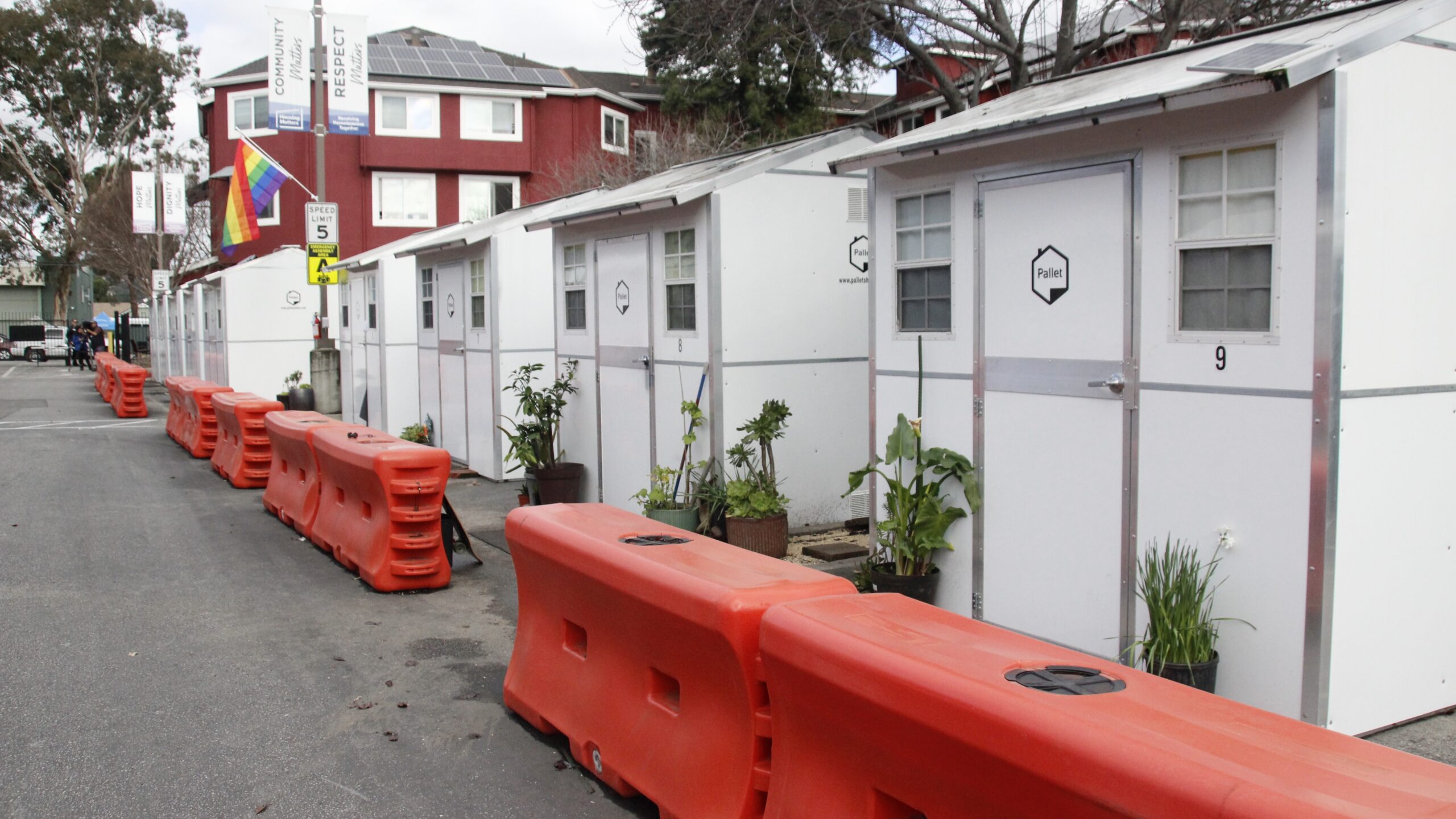
Pallet shelters at Housing Matters on Coral Street in Santa Cruz in January. (Jesse Kathan — Santa Cruz Local)
City sales tax increase on March 5 ballot
City leaders have said that many homeless services are set to lose funding after July 1.
Santa Cruz city voters will consider Measure L in the March 5 election, which is a proposed Santa Cruz city sales tax increase that would add about $8 million to the city’s General Fund annually.
That money would be just enough to cover the operating costs associated with the homeless response plan’s budget. However, the funding priorities listed in the ballot text range from wildfire preparation to fixing potholes. Legally, the money could be used for any city purpose.
“Much of our funding comes from one-time grants that are funded through the state. But again, that’s one-time funding, and that’s not an ongoing commitment of funds that we need to have to resolve and solve this problem of homelessness,” said Murphy.
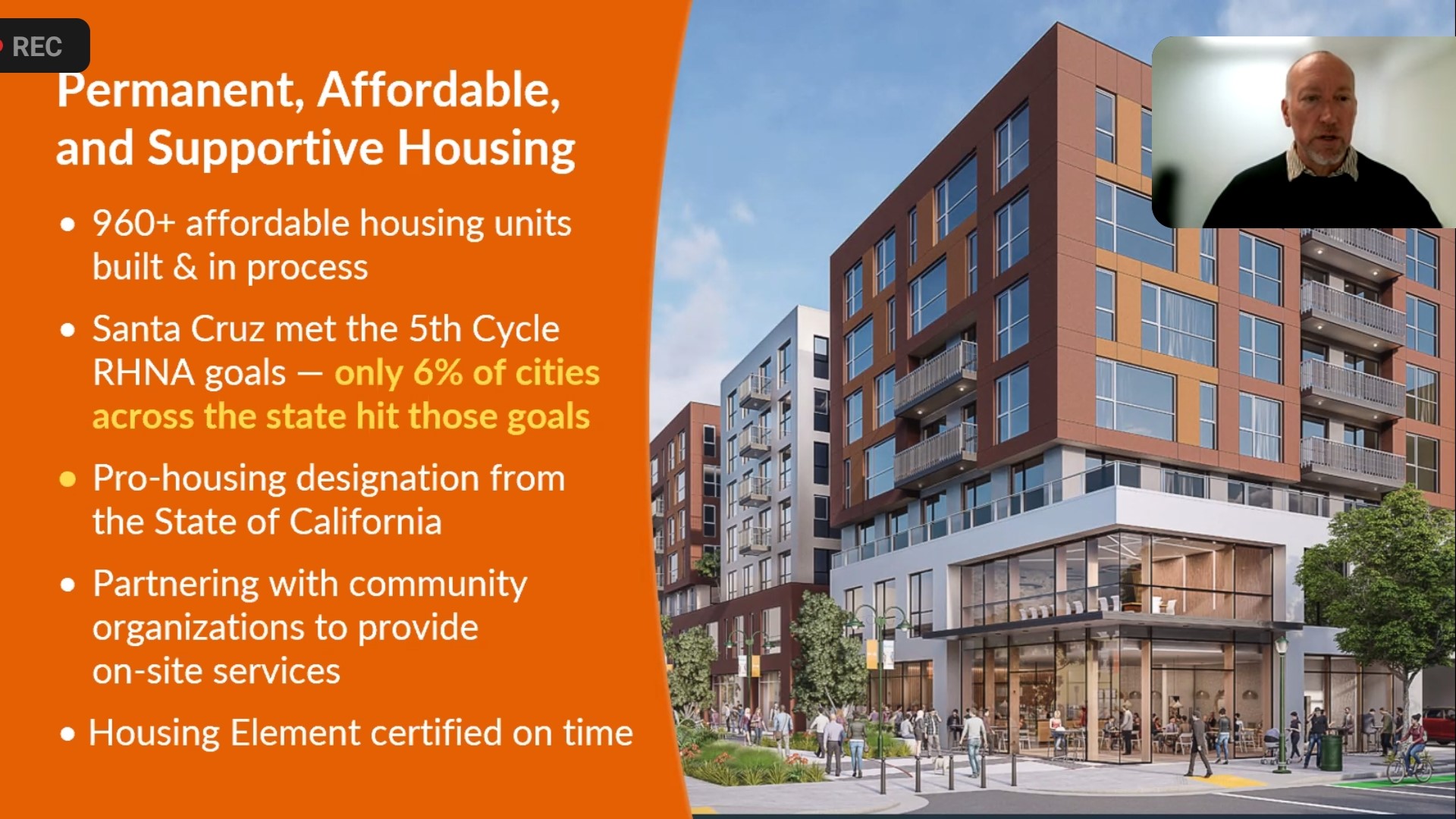
Santa Cruz Homelessness Response Manager Larry Imwalle said the city recently exceeded a Regional Housing Needs Allocation goal. (City of Santa Cruz screenshot)
Murphy said state and federal government spending is not sufficient to solve homelessness in California.
To end homelessness in the state by 2035, “California needs to build 112,527 affordable homes, fund operating and rental subsidies to 225,053 households, provide supportive services for 62,966 individuals and families, and fund interim interventions like shelters for 32,235 Californians experiencing homelessness” according to the nonprofit Corporation for Supportive Housing. A report by the group stated that homeless services spending should be $8.1 billion annually through 2035. Annual state and federal spending was about $1.2 billion in 2022.
The state budget “does not reflect this long-term commitment that’s needed to solve homelessness,” Murphy said.
Read more
- How homeless services money has been spent in Santa Cruz County — May 5, 2023
- Election Guide, March 5, 2024: Measure L – City of Santa Cruz sales tax increase
- Options and obstacles with new RV parking rules in Santa Cruz — Nov. 17, 2023
- Santa Cruz city leaders point to progress on homelessness — Dec. 13, 2022
Questions or comments? Email [email protected]. Santa Cruz Local is supported by members, major donors, sponsors and grants for the general support of our newsroom. Our news judgments are made independently and not on the basis of donor support. Learn more about Santa Cruz Local and how we are funded.
Tyler Maldonado holds a degree in English from the University of California, Berkeley. He writes about housing, homelessness and the environment. He lives in Santa Cruz County.


